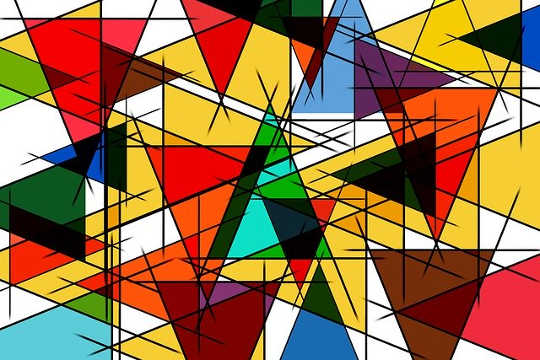
Image by Gerd Altmann
Holos means “ whole” in classical Greek, and tropic means “tendency or orientation toward”— e.g., toward a particular state or condition.
The coherence-building process in the universe is a real but subtle process. In the contemporary world it is often diverted and dominated by existential, more directly survival-oriented forces and impulses. These forces and impulses are not necessarily holotropic; they tend to be self-centered and competitive. They polarize the world, rather than heal it. Not surpisingly incoherence—or at least a lack of coherence—is prevalent in our world.
Yet a deeper look discloses that below the surface of incoherence, competition, and chaos, coherence-building “holotropic” developments are taking place. They emerge in various domains in society: in the sphere of business, in the economy, in education, in technological development, and even in politics.
Art, literature, music, and the entire field of culture are not explicitly included in this survey. The reason is that the search for harmony, and hence for coherence, is not an emerging or recurrent trend in these fields; it is a defining characteristic.
Kingsley Dennis, a close collaborator of the author, conducted research on holotropic developments in society and contributed the following overview.
HOLOTROPIC DEVELOPMENTS IN THE STRUCTURE OF COMMUNITIES
- Communities from local neighborhoods to entire states are moving beyond conventional hierarchical structures and relations toward decentralized networks that connect people. Development in any community is increasingly reaching others and has an impact on the others.
- As people connect with one another on multiple levels, from the local to the global, empathy is growing among people, whether they are next to each other or on opposite sides of the world. Communication creates ties between people, and between people and nature.
- New media platforms are shifting social structures and organizations away from top-down forms toward decentralization and distributed power relations. Controlling hierarchies are weakening as information technologies allow greater transparency, exposing corruption and illegal or criminal intent. As a result, fears over surveillance and violations of privacy appear exaggerated and are diminishing.
HOLOTROPIC DEVELOPMENTS IN TECHNOLOGICAL INNOVATION
- Discoveries in science give rise to revolutionary “disruptive” technologies, such as artificial intelligence (IT), robotics, the Internet of Things (IoT), biotechnology, energy storage, and quantum computing. These technologies transform established structures and practices and open the door to innovation and creativity.
- Technologies that enhance connection and use connection to create transparency are replacing technologies of supervision and control. Open “cloud” technologies are becoming the standard in data collection, storage, and sharing.
- The new technologies encourage research and development in hitherto unexplored areas of potential relevance to human life and well-being, such as the study of consciousness and transpersonal communication.
- A new “media ecology”— social media, video production, gaming platforms, augmented reality, and citizen journalism, among others— empowers people to produce and share their dreams and aspirations, as well as their hopes and frustrations.
HOLOTROPIC DEVELOPMENTS IN THE FIELD OF HEALTH
- Health and well-being are coming to be seen as dependent in a large measure on the integrity of nature. Environmental protection is moving from being a well-meaning charity to a basic requirement of healthy human life.
- The health sector is shifting from dealing with preconceived therapies and synthetic drugs to natural remedies and practices demanded and promoted by health-conscious individuals.
- People are learning to trust their own bodies more than commercially motivated prescriptions; they are beginning to rely on their own intrinsic intelligence.
- More and more people seek to live in tune with the rhythms and balances of nature. Living nature is becoming recognized as a major source and an essential resource of health and well-being. A plethora of new health disciplines are arising, such as information and energy medicine and “return to nature” therapies.
HOLOTROPIC DEVELOPMENTS IN EDUCATION
- Thanks to advances in interactive media technologies, the range and sources of learning are expanding from the local to the global. The new learning environments are international, intercultural, and interactive. They bring together learners with teachers from around the world.
- The learning environment is no longer limited to one-way communication between teacher and student. The classical classroom is disappearing.
- The objective of education is shifting from handing to students preconceived schemes that fit them into existing niches in business and society to producing skills and techniques that help students become co-creators of their curriculum. The new generation of learners are content developers and not merely content consumers.
HOLOTROPIC DEVELOPMENTS IN THE AREA OF LIFESTYLES
- Social status is no longer measured only by how much money one makes and how much luxury and ostentation one accumulates, but also, and increasingly, by how one spends one’s money and how sanely one leads one’s life.
- Changes in values and ideals shape and shift the living environment; in many parts of the world, city, town, and national administrations are responding to demands for socially and ecologically sound environments. Megacities and dense urban hubs are decentralizing, giving way to suburban communities and rural living spaces that allow contact with peers and with nature.
HOLOTROPIC DEVELOPMENTS IN THE ECONOMY
- Alternative forms of economic organization are arising in the footsteps of new technologies of networked communication and distributive computation. In the emerging economies, nature is not a burdensome externality but an organic part of the system of life.
- Economic activity is increasingly decentralized, with its center of activity moving from the international to the local level. In its advanced form it is focusing on the exploration and exploitation of the human and natural resources offered by the local environment.
- Economic growth is less and less a goal and value in itself; it is increasingly assessed in reference to its human and natural benefits and its social capital. The aspiration is to find and maintain a socially and ecologically beneficial scale and size of economic activity.
- Offshore activities and tax havens are more and more monitored. There are increasing shifts to make obscure financial transactions more transparent and to be gradually replaced by transactions between communal institutions, ethical banks, and other social-benefit-oriented financial organizations and instruments.
- More and more financial institutions will trade in and accept digital currencies. This will give rise to various nongovernmental currencies that will prove popular among a younger generation. New forms of digital currencies will also help to finance localized projects and creative start-ups.
- Inspired by the example of Bhutan’s Gross National Happiness scheme, in many quarters human well-being is considered the criterion of economic success. Slowly but significantly, economics is becoming, in E. F. Schumacher’s words, “a system working as if people mattered.”
HOLOTROPIC DEVELOPMENTS IN BUSINESS
- The belief that business companies exist to make money for their owners and shareholders is giving way to the recognition that the objective of companies is to serve the well-being of the people whose lives are touched by the company— the stakeholders.
- Achievement in business is not measured mainly by increase in market share and profitability, but by the contribution of the company to the life and well-being of its employees, collaborators, customers, and home communities.
- As individual initiatives are more valued and a wider range of voices and values are taken into account in a company’s management, collisions and conflict are not suppressed, but explored in view of finding collaborative solutions. As a result, levels of trust are rising in many quarters of the business world.
HOLOTROPIC DEVELOPMENTS IN POLITICS
- In advanced-thinking parts of the world, seizing and holding power is not the unique or even the principal goal of politics. In those countries, professional politicians are increasingly replaced by socially conscious and ethically committed citizen-activists.
- Force of arms and weapons of destruction are becoming recognized as dangerous and in the last count unnecessary instruments. Criminals and potential aggressors are better reeducated and reintegrated than forcefully suppressed or eliminated.
- In some advanced-thinking circles, there is a faint but growing realization that as long as motivations for aggression and violence can be countered by nonviolent means, security can be assured without giant military establishments and weapons of mass destruction. Creating modest- size police forces that wield just sufficient power to keep potential aggressors and criminals in check may suffice when backed by national and international emergency forces.
Developments in all these areas exhibit a common feature. Rather than separating, they integrate; they seek balance and coherence. They heal fissions and ruptures, countering voluntary or involuntary animosity and aggression. They are indications that even in the absence of conscious directives, whether from civil society or from government, there are groups and communities that are becoming significantly holotropic.
These advanced-thinking and apprehending communities curate contact and communication between their members, and between their members and other communities. They appear to be guided by an intuitive apprehension of holotropism: feelings of solidarity, empathy, and compassion. These culminate in a few precious if as yet rare instances in actions and behaviors that testify to genuine love evolving among their members, and between their members and other communities.
DEVELOPING HOLOTROPISM IN OURSELVES
THE FORMATIVE drive or impetus present in the universe, the holo-tropic attractor, leaves its mark on human consciousness, and this shows up in developments on the contemporary scene. Some of these developments are unsuspectedly connection- and wholeness- oriented: they are “holotropic.” Some fields of activity and interest, and some communities of living and working achieve a notable form and level of holotropism.
As these lines are written, even the mainstream media has partially reversed its focus on some previously derided and dismissed subjects, such as UFOs, other dimensions, and similar “esoteric” phenomena. This shift is occurring even though the bulk of modern people still holds to the secular materialist paradigm developed during the Renaissance, the Enlightenment, and through the scientific and industrial revolutions.
A timely spread of holotropism is not a utopian prospect. We know that there is an intrinsic tendency in the universe toward complexity and coherence; toward the formation of complex and coherent systems. We are part of the universe, and deep down we share this tendency. There are impulses in our subconscious and even in our conscious mind that perceive the allure of wholeness and oneness, and seek to align us with their dictates.
The world is changing, and our thinking is changing as well. A breakthrough to a new view of the world, and thus to a new way of relating to the world, is no longer merely possible; it is becoming plausible.
WAYS TO BECOME HOLOTROPIC
If we bring up the courage and the detemination, we can align with the holotropic attractor that shapes development in us and around us. The question is whether we will bring up the courage and the determination, and do so in good time. This is a crucial question because, as Gandhi said, we need to be the change we want to see in the world. If we are to effectively champion holotropic development in the world, we need to become holotropic ourselves.
There are many ways we could become holotropic— many ways we could develop a tropism for wholeness and coherence in ourselves. We could join the solidarity and compassion-oriented movements already launched in areas as diverse as health and education, and business and politics. We could also create, or try to create, coherence-oriented movements around us. The path we choose could be the personal path of a spiritual leader, a shaman, or a yogi, or the public path of a social and political activist—or a combination of these paths pursued simultaneously.
The key requirement is the spread of holotropism in the contemporary world. For the present, the urgent is dominating the important in people’s thinking. Most people focus on the most urgent tasks in front of them, taking one thing at a time. This is a human trait, and it is useful for assuring our existence in the world. But it fragments the world into individual paths and fields of interest and is not conducive to promoting coherent development.
There is no alternative to aligning with the attractor that shapes development both in us, and in the world. We can do so, because wholeness and connection is not something we impose on ourselves and on others: fundamentally, we are already connected and whole. We just need to bring this connection and this wholeness to the level of our everyday consciousness. This still remains to be done. For the present, rather than bringing these impulses to our consciousness, we are burying them under a mountain of existential tasks and worries.
We have divorced ourselves from the natural world. This has many manifestations and consequences. To begin with, we are no longer aligned with the rhythms and balances of nature.
We are built into the rhythms of the earth, but we create our own rhythms that often conflict with them. Rising with the sun and retiring with the sun is to align with the twenty-four-hour circadian rhythm created by the movement of the earth around the sun, and so-called primitive people still live in harmony with nature, and so do most of the remaining indigineous and traditional cultures.
But modern people disregard nature’s rhythms and balances and believe that they can replace them by turning lights and other artificial conveniences on and off with the flip of a switch. But our body does not align with artificial thythms, and we suffer the consequences. The effectiveness of our immune system is impaired, and diseases can proliferate. We have become “out of sync” with our biological clock.
Modern populations are urban dwellers, and have limited contact with nature. They live in an artificial world, and believe that it is the real world. They hold themselves superior to all other forms of life and hold that they can master nature as they wish.
Even just fifty years ago, animal intelligence researcher Jane Goodall had to fight the still dominant belief that chimpanzees are biochemical stimulus-response mechanisms, not living and feeling beings. Today, we realize that not just higher mammals, but all living organisms, and even trees and plants, are sensitive living beings, and they are not fundamentally dif-fer ent from us.
In the best interest of our physical and mental wellbeing, and in the primary interest of ensuring the continuation of the human adventure on the planet, that we need to rectify these misconceptions and errant behaviors. We need to reconnect to nature. When we do so, we reenter a community of living, feeling beings.
Copyright 2020 by Ervin Laszlo. All Rights Reserved.
Reprinted with permission from Reconnecting to the Source.
Publisher: St. Martin's Essentials,
an imprint of St Martin's Publishing Group
Article Source
Reconnecting to the Source: The New Science of Spiritual Experience
by Ervin Laszlo
 This revolutionary and powerful book will challenge you to reconsider the boundaries of our own experience and change how we look at the world around us. It is a unique, never before available resource for people who want to know how they can consciously align with the forces and “attractors” that governs the universe, and brought us, living, conscious people on the scene in the great processes of evolution that unfold here on Earth.
This revolutionary and powerful book will challenge you to reconsider the boundaries of our own experience and change how we look at the world around us. It is a unique, never before available resource for people who want to know how they can consciously align with the forces and “attractors” that governs the universe, and brought us, living, conscious people on the scene in the great processes of evolution that unfold here on Earth.
Click here for more info and/or to order this paperback book. Also available as a Kindle edition, an Audiobook and an Audio CD
About the Author
 Ervin Laszlo is a philosopher and systems scientist. Twice nominated for the Nobel Peace Prize, he has published more than 75 books and over 400 articles and research papers. The subject of the one-hour PBS special Life of a Modern-Day Genius, Laszlo is the founder and president of the international think tank the Club of Budapest and of the prestigious Laszlo Institute of New Paradigm Research. He is the author of Reconnecting to the Source (St. Martin’s Press, New York, March 2020).
Ervin Laszlo is a philosopher and systems scientist. Twice nominated for the Nobel Peace Prize, he has published more than 75 books and over 400 articles and research papers. The subject of the one-hour PBS special Life of a Modern-Day Genius, Laszlo is the founder and president of the international think tank the Club of Budapest and of the prestigious Laszlo Institute of New Paradigm Research. He is the author of Reconnecting to the Source (St. Martin’s Press, New York, March 2020).




























